
Tradition: Games with Incense

You’ve probably heard of the traditional Japanese Tea Ceremony. Did you know that incense is just as important an art in Japan as tea or Ikebana?
The ancient Japanese tradition of incense, or Kodo, holds a deep cultural significance. Originating in the Heian period, it quickly became a favorite pastime of the nobility, who elevated incense appreciation into an art form. Central to the Kodo ceremony are incense games, also known as Kumiko (Ku-me-koh). These games are designed to stimulate the senses by “listening” to incense, rather than simply smelling it. In this practice, one attunes not only to the fragrance but to the feelings and memories it evokes, fostering a mindful experience.
Kodo: The Art of Listening to Incense
In Kodo, participants don’t just smell incense, they “listen” to it. This poetic expression highlights the ceremony's emphasis on mindfulness and attention. Whether through historical themes, waka poetry, or seasonal inspirations, the games encourage a deeper connection with the natural world. Each session is an invitation to focus on the subtleties of scent and escape into an inner world of calm.
Kodo is not about competition; there are no winners or losers. Instead, it celebrates the simple elegance of enjoying fine incense with others. For those interested in experiencing these games, here are some examples that can be enjoyed with friends or family.

Game of Three
This is one of the most straightforward incense games. Players are presented with three types of agarwood and tasked with identifying whether the scents are identical or different.
1. Three different pieces of agarwood are carefully prepared and placed in small packets.
2. Each guest "listens" to the three woods as they pass around a Kodo cup carefully filled with ash and a piece of charcoal to help the incense release its fragrance smoothly.
3. The goal is to determine if the fragrances are similar or distinct, marking the results on scoring sheets. The incense presenter, or Komoto, then reveals the correct answers.
Three Scenic Places
In this game, players are transported to iconic locations through the power of fragrance. Three different types of aloeswood represent specific places, such as Matsushima, Amanohashidate, and Itsukushima. The game also includes a fourth wood, symbolizing the boat that takes you to these destinations.
1. The Komoto announces the three places and presents the sample aloeswood for each.
2. Guests then attempt to identify each fragrance without knowing which wood is being presented.
3. Depending on how well players guess, they are said to experience the places in either perfect weather or misty obscurity.

The Rikkoku Journey
For more experienced incense enthusiasts, the Rikkoku Journey offers a challenge involving six types of aloeswood, known collectively as the Rikkoku set. Each type has its own unique characteristics, and the game asks players to match the scent to its traditional description.
1. Six distinct kinds of aloeswood are prepared and passed around.
2. Guests "listen" to each fragrance and match it to one of the six official descriptions.
3. As the scents unfold, the participants are taken on a journey through history and tradition, reconnecting with ancient practices.
Kodo and the incense games it offers provide a unique opportunity to slow down and appreciate the world of scents. Whether you’re enjoying the simple elegance of the Game of Three or embarking on the more complex Rikkoku Journey, these games offer a chance to savor the subtle beauty of Japanese incense traditions!
Read our last articles here :
The Stress-Relief Diet: How Nutrition Can Support a Balanced Mind
Tradition : Discover Japan August Festival
Creating A Peaceful Space: How to Choose Your Incense
. . .


